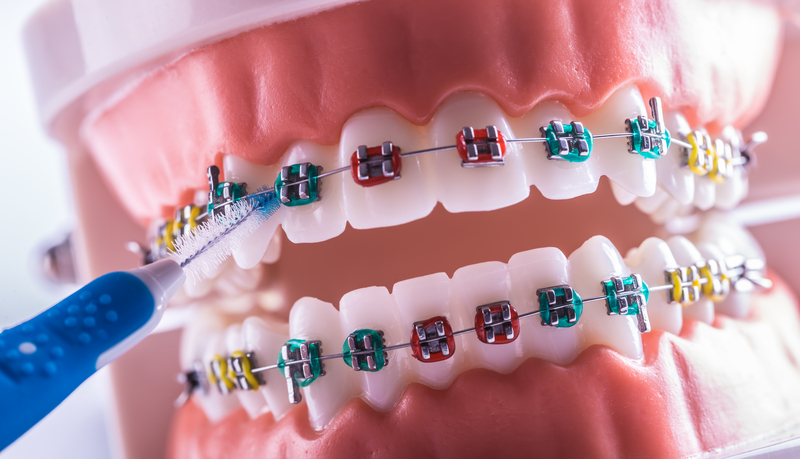Subtotal $0.00
How Braces Actually Move Your Teeth (It’s More Fascinating Than You Think)
Key Takeaways
- Braces use gentle, continuous pressure— they gradually shift teeth by guiding them through a biological process called bone remodeling, where bone breaks down and rebuilds around the moving tooth.
- It’s not just the teeth that move— the surrounding bone and periodontal ligament adapt in response to the force applied by braces, allowing safe, stable repositioning over time.
- Each part of the braces system matters, from brackets and archwires to elastics. Together, they apply targeted force to move teeth into their ideal positions.
- Consistency is key to success— regular adjustments and following your orthodontist’s instructions (like wearing elastics) keep treatment on track and prevent delays.
- Braces offer health benefits beyond aesthetics, including improved bite alignment, reduced jaw strain, easier oral hygiene, and long-term dental health protection.
When people think of braces, they often picture a metal smile and monthly orthodontic visits. But what’s happening behind the scenes is a truly incredible biological process. Braces don’t just shift teeth—they orchestrate a careful, bone-remodeling ballet that gradually reshapes your entire bite. Let’s pull back the curtain and explore how it all works, step by step.
The Structure of Your Smile
Before diving into how teeth move, it helps to understand what holds them in place. Contrary to popular belief, teeth aren’t anchored directly into bone like nails into wood. Each tooth sits in a socket and is suspended by a complex web of connective tissue known as the periodontal ligament (PDL).
The PDL acts as a shock absorber and communication hub, sending signals between the tooth and jawbone. Surrounding all of this is the alveolar bone, a specialized bone that supports the teeth. This entire structure is dynamic—it constantly remodels in response to forces from chewing, grinding, or… braces.
The Science of Orthodontic Force
Braces work through a combination of gentle, consistent pressure and time. Whether you’re wearing traditional metal braces or Invisalign, the principle is the same: apply force in a specific direction to encourage the tooth to move.
When a tooth is pushed in one direction, the body responds in two distinct ways:
- On the pressure side, the PDL compresses, signaling cells called osteoclasts to break down bone in that area.
- On the tension side, where the ligament is stretched, osteoblasts arrive to build new bone behind the moving tooth.
This process is known as bone remodeling, and it’s what allows your teeth to safely shift position without becoming loose or damaging the jaw. It’s slow and methodical—typically requiring 18 to 24 months for most full treatments.
Braces vs. Aligners: Different Tools, Same Goal
Traditional braces use brackets, wires, and elastic bands to guide each tooth’s movement. The wires are adjusted over time to gradually increase or redirect the pressure. On the other hand, Invisalign and other clear aligners use a series of plastic trays custom-made for your teeth, each one slightly different from the last.
While the delivery methods are different, both systems rely on controlled force and the body’s natural bone remodeling process. A 2017 review in the American Journal of Orthodontics and Dentofacial Orthopedics confirmed that both braces and clear aligners achieve similar biological effects, although braces may offer more precise control for complex movements .
Microscopic Changes With Massive Results
Here’s the truly fascinating part: all of this movement happens on a microscopic scale. The pressure from braces stimulates cellular activity at the molecular level. Chemical signals like prostaglandins and cytokines activate the osteoclasts and osteoblasts, transforming your bone over time.
The rate of tooth movement is influenced by factors like:
- Age (younger patients typically respond faster)
- Bone density
- Genetics
- Overall health and diet
- Oral hygiene (gum inflammation can slow movement)
That’s why orthodontists tailor each treatment plan based on your individual biology, not just the alignment of your teeth.
Why Adjustments Matter
Every time you visit your orthodontist for a tightening (or receive a new Invisalign tray), it’s not just a checkup—it’s a strategic move. These small changes ensure your teeth keep moving in the right direction and at the right pace.
The goal is to maintain a controlled level of pressure that encourages movement without overwhelming the tissues. Too much force can damage the roots or cause resorption, while too little may stall progress entirely.
That’s also why orthodontic treatment takes time. Rushing it could harm your teeth and surrounding bone. Patience isn’t just a virtue—it’s part of the science.
The Final Step: Retention
Once your teeth are in their ideal position, treatment doesn’t end. The bone and tissues around your teeth need time to stabilize in their new configuration. Without a retainer, there’s a risk your teeth will begin drifting back—what orthodontists call relapse.
Wearing your retainer helps ensure your hard-earned smile lasts a lifetime by giving the bone a chance to fully regenerate and hold everything in place.
Beyond Aesthetics: The True Purpose of Braces
While many patients seek braces for cosmetic reasons, the benefits go far deeper:
- Better oral health: Straight teeth are easier to clean, reducing your risk of cavities and gum disease.
- Improved bite function: Proper alignment helps with chewing, speaking, and reduces strain on your jaw.
- Reduced wear: Crooked teeth can wear unevenly or cause long-term damage to enamel.
Braces aren’t just about looking good in photos—they’re about setting the foundation for lifelong oral health.
Final Thoughts: A Natural Process with a Modern Touch
Braces might look like simple hardware, but they’re guiding a complex biological process that’s been built into our bodies all along. Thanks to modern orthodontics, this natural process can be harnessed with precision and predictability—helping people of all ages achieve smiles that are not only beautiful, but also healthy and functional.
So the next time you (or your child) sit in that orthodontist’s chair, know this: what’s happening isn’t just cosmetic—it’s science at work, slowly, silently reshaping your smile one cell at a time.





Comments are closed